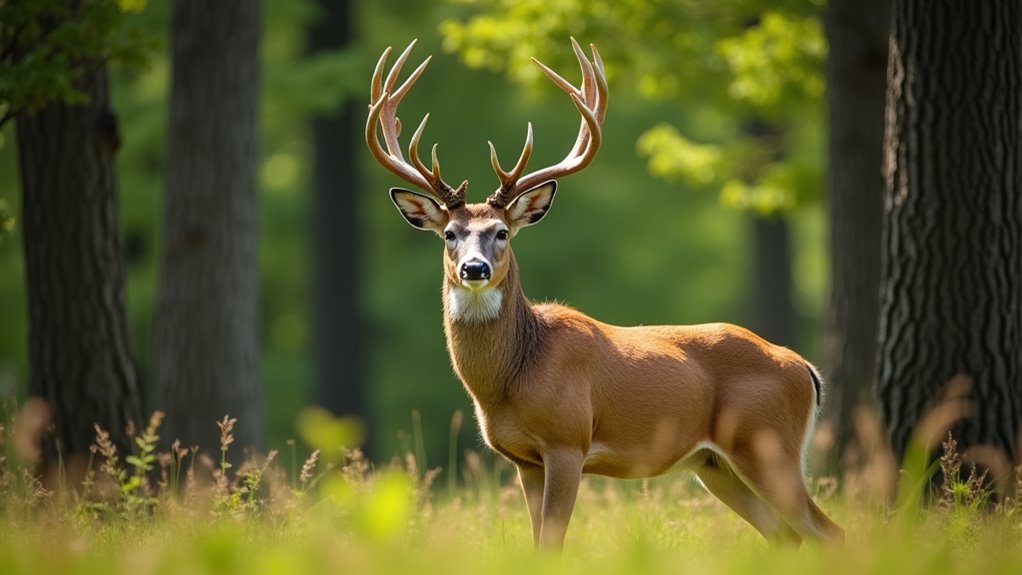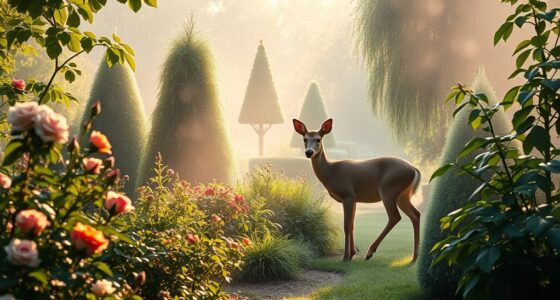Deer are incredible animals with fascinating facts that keep surprising you. They grow impressive antlers each year, which males use for fights and attracting mates, signaling health and strength. They can run up to 30 miles per hour, helping them escape predators easily. Deer adapt well to different habitats, moving seasonally between forests, grasslands, and even suburbs. Their behaviors and environment choices reveal their resilience. If you keep exploring, you’ll uncover even more of these amazing deer secrets.
Key Takeaways
- Male deer grow impressive, branched antlers annually, signaling health and attracting mates during the rut.
- Deer can reach speeds up to 35-40 miles per hour, allowing quick escapes from predators.
- Antlers are shed and regrown each year, with larger ones indicating better fitness.
- Deer are highly adaptable, thriving in forests, grasslands, and suburban areas across seasons.
- During mating season, males spar using their antlers to establish dominance and attract females.

Deer are among the most recognizable and widespread mammals in the world, known for their graceful movement and distinctive antlers. As you observe these animals, you’ll notice that their behavior is often closely tied to their mating rituals and habitat preferences. During the breeding season, known as the rut, male deer engage in elaborate mating displays to attract females. You might see them sparring with other males, locking antlers in fierce battles that determine dominance. These rituals are essential for establishing hierarchy, as the strongest males usually secure access to the best mates. Understanding their mating behavior gives you insight into how critical antler development is, since larger, more impressive antlers often signal health and genetic fitness to females.
When it comes to habitat preferences, deer are quite adaptable but tend to favor areas that provide a mix of cover and open space. You’ll find them in forests, grasslands, and even suburban areas where they can find food and safety from predators. They prefer regions with dense underbrush or thick tree cover for concealment, yet they also seek out open patches for grazing. This balance allows them to forage efficiently while remaining hidden from threats. If you’re exploring a new area, look for deer near water sources, as they often stay close to streams, ponds, or wetlands. These spots offer both hydration and lush vegetation, which deer rely on for sustenance. Additionally, their ability to adapt to various environments helps them survive in changing conditions, demonstrating their resilience. Habitat diversity also plays a significant role in their survival across different regions.
Deer’s habitat preferences are also influenced by seasonal changes. In summer, they tend to stay in cooler, shaded areas with abundant foliage. As winter approaches, they might move to lower elevations or more sheltered spots where snow is less deep and food is easier to find. Their ability to adapt to different environments helps them survive in a variety of landscapes, from remote wilderness to busy suburbs. The development of antlers is also critical for their survival and success during the rut, as larger antlers can intimidate rivals and attract mates. Understanding where deer prefer to live and how they behave during mating season can help you appreciate their complexity and resilience. Whether you’re observing them in a forest or spotting their tracks in a meadow, recognizing the connection between their mating rituals and habitat choices allows you to see these mammals in a new light. Their delicate balance between social behavior and environmental needs highlights how well-adapted they are to thrive across diverse ecosystems.
Frequently Asked Questions
How Do Deer Communicate With Each Other?
You might wonder how deer communicate with each other. They use a combination of deer vocalizations and body language to send messages. For example, they grunt, snort, or make specific sounds to warn others of danger or establish dominance. Additionally, their body language, like ear positions, tail flicks, or posture, helps convey their mood and intentions, making their communication clear in their natural environment.
What Is the Lifespan of a Typical Deer?
You might think deer live forever, but their lifespan is surprisingly modest—about 6 to 14 years in the wild. Ironically, while deer hunting and migration often highlight their fleeting presence, many don’t reach old age. Factors like predators and harsh seasons cut lives short. So, if you’re lucky, you’ll witness a deer in its prime before it gracefully exits, reminding us how brief and precious their time really is.
Do All Deer Species Have Antlers?
Not all deer species have antlers. For example, female reindeer grow antlers, but most female deer don’t. Many deer species use camouflage to hide from predators, but antler growth is mainly for males during mating season. If you observe a deer with impressive antlers, it’s likely a male, using them to compete and attract mates. Deer’s camouflage helps them stay hidden, while antlers signal strength and health.
How Do Deer Adapt to Urban Environments?
You might notice deer adapting well to urban environments by engaging in urban foraging, where they find food in parks and gardens. They also become more alert to avoid predators like dogs and cars, using their keen senses to stay safe. By adjusting their behavior, deer can thrive amid human activity, making predator avoidance and resourcefulness key to their survival in these changing settings.
What Is the Role of Deer in Their Ecosystems?
You see, deer play a essential role in their ecosystems by supporting biodiversity and maintaining healthy plant populations. Their migration patterns help distribute seeds and nutrients across different areas. During predator evasion, they rely on speed and agility, which influence predator-prey dynamics. By grazing, they control vegetation growth, preventing overgrowth. Overall, deer contribute to ecological balance, ensuring the sustainability of their habitats for various species.
Conclusion
Now that you’ve uncovered these incredible deer secrets, you can see just how remarkable they are. Their antlers, swift moves, and quiet grace make them nature’s gentle wonders. Next time you spot a deer in the wild, remember there’s a whole story of silent strength and delicate beauty behind that calm exterior. Appreciating these subtle marvels helps you see the world with fresh eyes, where even the quietest creatures hold a touch of magic just waiting to be discovered.










